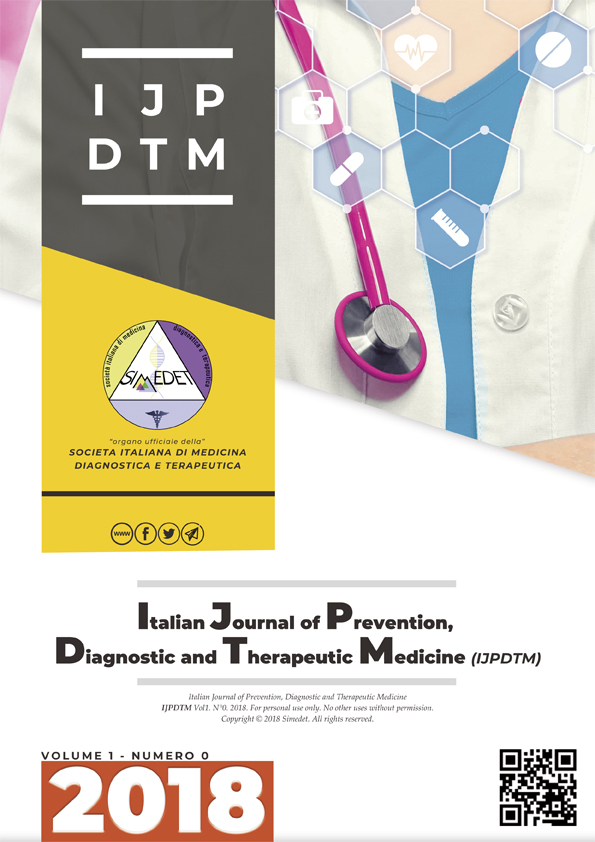Trattamento off-label con omalizumab: un caso clinico
Contenuto principale dell'articolo
Abstract
introduzione
Omalizumab è un anticorpo monoclonale anti-Ig, indicato come terapia aggiuntiva nei pazienti con asma grave non controllato. La terapia è guidata da un nomogramma basato su IgE totali e pesi dei pazienti.
Scopo
Scopo di questo caso è descrivere il trattamento off-label con omalizumab e dimostrare l'efficacia di questo trattamento nonostante l'elevata IgE totale.
Presentazione del caso
Presentiamo un caso di un paziente seguito nel nostro Centro di allergologia pediatrica dal 2012 per asma allergico grave persistente, trattato con il dosaggio massimo di fluticasone, montelukast, salmeterolo continuo e cicli di steroidi, senza cambiamenti clinici e spirometrici. Nonostante l'elevata IgE totale del paziente e con il suo consenso, abbiamo deciso di iniziare il trattamento con omalizumab (600 mg ogni 15 giorni) con progressivo miglioramento della spirometria e test di broncodilatazione negativi. Alla fine del trattamento, abbiamo notato un improvviso peggioramento della spirometria e una significativa esacerbazione dell'asma per un periodo di 6 mesi di trattamento con omalizumab. Sulla base di questi dati, ha rinnovato omalizumab.
Conclusione
Abbiamo riportato un caso di un adolescente trattato off-label con omalizumab. Il caso verifica come i pazienti con asma allergico grave possano trarre beneficio dalla terapia con omalizumab nonostante l'elevato totale
IgE. Ulteriori studi saranno necessari per valutare gli effetti benefici a lungo termine di questa scelta terapeutica.
Downloads
Dettagli dell'articolo

Questo lavoro è fornito con la licenza Creative Commons Attribuzione - Non commerciale - Non opere derivate 4.0 Internazionale.
Riferimenti bibliografici
Global Initiative for Asthma Global Strategy for Asthma
Management and Prevention. 2016 www.ginasthma.com
Anandan C., Nurmatov U., van Schayck O.C., Sheikh A. Is
the prevalence of asthma declining? Systematic review of epidemiological
studies. Allergy. 2010;65:152–167. [PubMed]
Froidure A., Mouthuy J., Durham S.R., Chanez P., Sibille
Y., Pilette C. Asthma phenotypes and IgE responses. Eur. Respir. J.
;47(1):304–319. [PubMed]
Bozzetto S., Carraro S., Zanconato S., Baraldi E. Severe asthma
in childhood: diagnostic and management challenges. Curr. Opin. Pulm.
Med. 2015;21(1):16–21. [PubMed]
O’Byrne PM, Pedersen S, Schatz M, Thoren A, Ekholm E,
Carlsson LG, et al. The poorly explored impact of uncontrolled asthma.
Chest. 2013;143:511–513. doi: 10.1378/chest.12-0412. [PubMed]
Global Initiative for Asthma Report. Global strategy for asthma
management and prevention (updated 2016).
https://www.ginasthma.org. Accessed 07 June 2017.
Licari A., Marseglia G., Castagnoli R., Marseglia A., Ciprandi
G. The discovery and development of omalizumab for the treatment of
asthma. Expert Opin. Drug Discov.2015;10(9):1033–1042. [PubMed]
Ciprandi G., Marseglia G.L., Castagnoli R., et al. From
IgE to clinical trials of allergic rhinitis.Expert Rev. Clin. Immunol.
;11(12):1321–1333. [PubMed]
Holgate S, Casale T, Wenzel S, Bousquet J, Deniz Y, Reisner C.
The anti-inflammatory effects of omalizumab confirm the central role of
IgE in allergic inflammation. J Allergy Clin Immunol. 2005;115:459–465.
doi: 10.1016/j.jaci.2004.11.053. [PubMed]
Prussin C, Griffith DT, Boesel KM, Lin H, Foster B, Casale
TB. Omalizumab treatment downregulates dendritic cell FcepsilonRI
expression. J Allergy Clin Immunol.2003;112(6):1147–1154. doi:
1016/j.jaci.2003.10.003. [PubMed]
Chung K.F., Wenzel S.E., Brozek J.L., et al. International ERS/
ATS guidelines on definition, evaluation and treatment of severe asthma.
Eur. Respir. J. 2014;43(2):343–373. [PubMed]
European public assessment report (EPAR) for Xolair. EMA
http://www.ema.europa.eu/docs/en_GB/document_library/EPAR_-_
Summary_for_the_public/human/000606/WC500057293.pdf [cited: 3rd
Dec 2016]
Omalizumab for treating severe persistent allergic asthma
(review of technology appraisal guidance 133 and 201). NICE National
Institute for Health and Care Excellence http://www.nice.org.uk/
Guidance/TA278.
Busse WW, Morgan WJ, Gergen PJ, Mitchell HE, Gern JE,
Liu AH, et al. Randomized trial of omalizumab (anti-IgE) for asthma
in inner-city children. N Engl J Med. 2011;364:1005–1015. doi: 10.1056/
NEJMoa1009705. [PubMed]
Teach SJ, Gill MA, Togias A, Sorkness CA, Arbes SJ, Jr, Calatroni
A, et al. Preseasonal treatment with either omalizumab or an inhaled
corticosteroid boost to prevent fall asthma exacerbations. J Allergy
Clin Immunol. 2015;136:1476–1485. doi: 10.1016/j.jaci.2015.09.008.
[PubMed]
Licari A, Castagnoli R, Denicolò C, Rossini L, Seminara M,
Sacchi L, et al. Omalizumab in Children with Severe Allergic Asthma:
The Italian Real-Life Experience. Curr Respir Med Rev. 2017;13(1): 36–
[PubMed]
Chung KF, Wenzel SE, Brozek JL, Bush A, Castro M, Sterk
PJ, et al. International ERS/ATS guidelines on definition, evaluation
and treatment of severe asthma. Eur Respir J.2014;43:343–353. Doi:
1183/09031936.00202013. [PubMed]
Montella S, Baraldi E, Cazzato S, Aralla R, Berardi M, Brunetti
LM, et al. Severe asthma features in children: a case-control online survey.
Ital J Pediatr. 2016;42:9. doi: 10.1186/s13052-016-0217-z.[PubMed]
Fitzpatrick AM, Gaston BM, Erzurum SC, Teague WG,
National Institutes of Health/National Heart, Lung, and Blood Institute
Severe Asthma Research Program Features of severe asthma in schoolage
children: Atopy and increased exhaled nitric oxide. J Allergy Clin
Immunol. 2006;118:1218–1225. doi: 10.1016/j.jaci.2006.08.019.
[PubMed]
Rodrigo GJ, Neffen H. Systematic review on the use of
omalizumab for the treatment of asthmatic children and adolescents.
Pediatr Allergy Immunol. 2015;26:551–556. doi: 10.1111/pai.12405.
[PubMed]
Sztafinska A, Jerzynska J, Stelmach W, Woicka-Kolejwa K,
Stelmach I. Quality of life in asthmatic children and their caregivers after
two-year treatment with omalizumab, a real-life study. Postepy Dermatol
Alergol. 2017;34(5):439-447. [PubMed]
Busse W, Buhl R, Fernandez Vidaurre C, Blogg M, Zhu J, Eisner
MD, et al. Omalizumab and the risk of malignancy: results from a pooled
analysis. J Allergy Clin Immunol.2012;129:983–989. doi: 10.1016/j.
jaci.2012.01.033. [PubMed]
Milgrom H, Berger W, Nayak A, Gupta N, Pollard S, McAlary
M, et al. Treatment of childhood asthma with anti-immunoglobulin
E antibody (omalizumab) Pediatrics. 2001;108:E36. doi: 10.1542/
peds.108.2.e36. [PubMed]
Molimard M, Mala L, Bourdeix I, Le Gros V. Observational
study in severe asthmatic patients after discontinuation of omalizumab
for good asthma control. Respir Med.2014;108:571–576. doi: 10.1016/j.
rmed.2014.02.003. [PubMed]
Busse WW, Trzaskoma B, Omachi TA, Canvin J, Rosen K,
Chipps BE, et al. Evaluating Xolair persistency of response after long-term
therapy (XPORT) Am J Respir Crit Care Med.2014;189:A6576.
Poddighe D, Brambilla I, Licari A, Marseglia GL. Omalizumab
in the therapy of pediatric asthma. Recent Pat Inflamm Allergy Drug
Discover.2018. doi: 10.2174/1872213X12666180430161351.
[Epub ahead of print]
Asai N, Ohkuni Y, Komatsu A, Matsunuma R, Nakashima
K, Kaneko N. Severe persistent asthma responsive to off-label use of
omalizumab despite high and low levels of total serum IgE. J Bras
Pneumol.2011;37(4):567-570. [PubMed]

